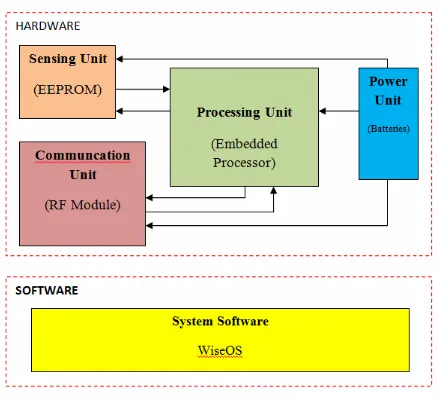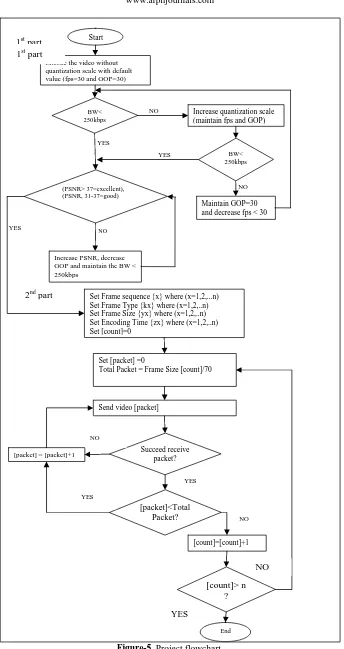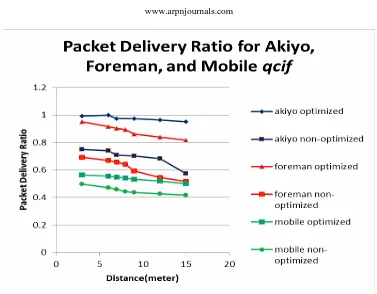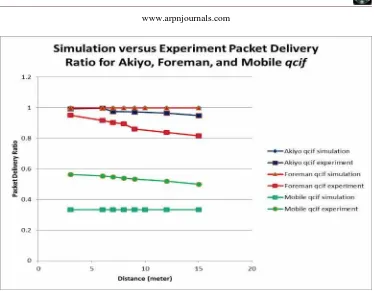DEPLOYMENT OF OPTIMIZED ALGORITHM FOR MPEG-4 DATA OVER
WIRELESS MULTIMEDIA SENSOR NETWORK
Norlezah Hashim1, Sharifah Hafizah Syed Ariffin2, Farizah Yunus2, Fakrulradzi Idris3 and Norsheila Fisal2
1Faculty of Engineering Technology, Universiti Teknikal Malaysia Melaka, Hang Tuah Jaya, Melaka, Malaysia 2UTM-MIMOS Center for Telecommunication Technology, UTM, Skudai, Malaysia
3Faculty of Electronics and Computer Engineering, Universiti Teknikal Malaysia Melaka, Hang Tuah Jaya, Melaka, Malaysia E-Mail: [email protected]
ABSTRACT
Typical Wireless Sensor Network (WSN) always deals with scalar data such as temperature. These types of data are suitable for low rate networking technology such as IEEE802.15.4. Transmitting a video for IEEE 802.15.4 raised other challenges for bandwidth limited sensor networks like WSN. The optimization method able to determine the optimal limit for quantization scale, group of picture and frame per second in order to suit the WSN environment. Changing these parameters affects the bandwidth requirement and video quality in term of Peak Signal to Noise Ratio (PSNR). This project aims to create an embedded code in TelG mote according to this concept. Results from experiment show improvements in packet delivery ratio of 28% for Akiyo qcif file, 27% for Foreman qcif file and 9% for Mobile qcif file. This work proved that the method has successfully increased the network performance.
Keywords: typical wireless sensor network, peak signal to noise ratio.
INTRODUCTION
Analysis in Wireless sensor network (WSN) often includes the study of network properties of wireless communication with small battery powered sensors. Nowadays some of WSN applications include disaster prevention, environmental monitoring, and logistics tracking. Most WSN uses IEEE 802.15.4 standard, is one of the interest due to its capability in producing low cost with low complexity but still maintaining the good quality of video. However, transferring a video is more challenging since it requires bigger bandwidth to carry bigger data and WSN only allow the maximum bandwidth of 250 kbps. Therefore a compression method such as MPEG-4 is needed before a video being transferred through WSN to reduce the requirement of its bandwidth.
The researchers in [1] have developed the benchmark for the settings of video encoding which can provide better video quality suitable for WSN application. They mentioned three parameters, namely quantization scale, group of picture, and frame per second that are important in determining the quality of a video received. The researchers used Network Simulator 2 (NS2) as an approach to the study. Even though simulation is a reliable approach to study the network properties, the real scenario of WSN is much more complicated. Therefore, a real world testbed implementation is needed to justify the results obtained using simulation. In this paper, the design, deployment and evaluation of WSN testbed using optimized algorithm to transmit MPEG-4 data will be discussed. The deployment will be done using TelG mote and WiseOS operating system. Results on packet delivery ratio and total packet loss at different distances are presented. Moreover, comparisons of results between MPEG-4 data with optimized algorithm and MPEG-4 data with non-optimized algorithm are further elaborated. Lastly, comparisons of results between experiment and simulation are presented to the readers.
The rest of this paper is organized as follows; Section 2 briefly describes the design concept of optimized parameter for MPEG-4 data, followed by testbed implementation in Section 3. In Section 4, the results obtained are elaborated and finally the conclusions are given in Section 5.
DESIGN CONCEPT
The standard for video compression which are MPEG-1[2] and MPEG-2 [3], are not versatile enough to efficiently address the requirement of multimedia application. Therefore, Moving Picture Expert Group (MPEG) developed MPEG-4 standard that provides a platform for a wide range of multimedia applications [4]. In [5-6], MPEG-4 video is already proven suitable to be transmitted over IEEE 802.15.4 standard. Many researchers focused research on MPEG-4 transmitted for IEEE802.11 standard that can support high bandwidth, such as in [7-8], and only a few researches done for MPEG-4 over IEEE802.15.4.
obtained but still within the bandwidth requirement of WSN and good PSNR value.
TelG system architecture
Figure-1 shows TelG system architecture used in testbed deployment. TelG hardware system architecture consists of sensing unit, communication unit, processing unit, and power unit [9]. TelG is particularly designed where programming, computation and communication are integrated onto a single device. Each TelG can be reprogrammed on the board using ISP.
In sensing unit, the electrically erasable programmable read only memory (EEPROM) is used to store MPEG-4 data before transmitting. ATmega644PV microcontroller from Atmel Corporation is used in TelG as the processing unit. ATmega644PV has its own advantage in term of low power consumption used [10]. In the communication unit, the wireless device is using the XBee module from MaxStream Inc. XBee is an IEEE 802.15.4 compliant radio based on Carrier Sense Multiple Access CSMA. TelG is battery powered, with a cutoff voltage of 1.8 V [10].
WiseOS was developed by a group of researchers from Telekom Research Group (TRG) of UTM. The programming language used for WiseOS is called nesC, which is C with some addition language features for components and concurrency. WiseOS is an event-driven operating system. Figure-2 shows TelG device used in experiment.
Figure-1. TelG system architecture.
Figure-2. TelG device.
Experiment setup
The experiment location is chosen at UTM block P19 as shown in Figure-3. Figure-4 shows the configuration setup which consists of three TelG points spaced equally among them. TelG node A acts as the source node, TelG node B is the intermediate node and base station behaves as the sink node. Besides, base station also collects all data and sent them to a Personal Computer for analysis purposes.
Figure-3. Experiment setup at P19, UTM.
Figure-4. Configuration setup.
METHODOLOGY
samples used in the testbed are Akiyo, Foreman and Mobile. These video samples appear as low, medium and high motion and scene complexity respectively. These video samples are commonly used among researchers. Table-1 shows the summary of the data used in this
research where six different sets of MPEG-4 data were conducted in the testbed. It can be seen when any value from the optimal value is varied, will result in the change of bandwidth requirement.
Table-1. Summary of the data used in experiment.
Type of motion Quantization scale
Before making any measurement, each TelG needs to be programmed according to the algorithm to test the proposed method. Figure-5 shows the overall flowchart of the proposed method. The flow chart is divided two parts. The first part is to select the optimal values for frame per second, quantization scale and group of frame while the second part is to transfer the video packets through WSN channel.
RESULT AND DICUSSIONS
Figure-6 shows the packet delivery ratio for three samples namely Akiyo, Foreman, and Mobile qcif data. In general, the packet delivery ratio was showing a decreased pattern when the distances between nodes are increased. As the distances are increased, it is reasonable to experience more losses because the probability a data to loss is increased as the signal strength is decreased. From the graph, packet delivery ratio for Akiyo optimized data improves an average of about 28 percents compared to non-optimized data, 27 percents differences for Foreman and 9 percents differences for Mobile.
It is observed from the graph, the improvement for Foreman is smaller than Akiyo as Foreman contains more packets which is twice the Akiyo’s total packets. This will increases the probability of packets dropping since the network is getting busy with packets transferring. From Table-1, it can be seen that in order to maintain the network bandwidth requirement not more than 250 kbps and to maintain the video quality in term of PSNR, Foreman’s file contains a smaller group of frame compared to Akiyo’s generated from the optimized method. Smaller group of frame increased the quantity of I frames, which constitutes to bigger file size and lower packet delivery ratio.
For Mobile, the optimized data improves the network of about 9 percents in averages compared to non-optimized data. Compared to Foreman and Akiyo, Mobile has the smallest improvement in term of packet delivery ratio. Mobile file represents a high motion and scene
complexity of a horizontally moving toy train with a calendar moving vertically in the background. Therefore, Mobile file’s size is bigger than Akiyo and Foreman which results in lowest packet delivery ratio.
In order to maintain the bandwidth requirement of Mobile below the maximum allowable rates of WSN, the value of quantization scale is increased to 4 (refer to Table-1). As we know quantization scale represents how much compression is done to the video. Increasing quantization scale will reduce the requirement of bandwidth but will introduce a lower video quality. However, by using the optimized method, the quality of the video is still maintained at a good PSNR value above 31 according to Mean Opinion Score (MOS) [1].
The packet loss versus distance graphs for Akiyo, Foreman and Mobile were shown in Figure-7. In overall, packet loss was showing an increased pattern when the distance between nodes are increased. From this figure, it is clearly observed that optimized MPEG-4 data improved the overall network performance for Akiyo, Foreman and Mobile by reducing the total packet loss.
Figure-5. Project flowchart.
YES
1st part
NO
NO YES
NO
YES Start
Increase quantization scale (maintain fps and GOP)
Increase PSNR, decrease GOP and maintain the BW < 250kbps
Maintain GOP=30 and decrease fps < 30
BW< 250kbps BW<
250kbps
(PSNR> 37=excellent), (PSNR, 31-37=good)
Encode the video without quantization scale with default value (fps=30 and GOP=30)
Set Frame sequence {x} where (x=1,2,...n) Set Frame Type {kx} where (x=1,2,..n) Set Frame Size {yx} where (x=1,2,..n) Set Encoding Time {zx} where (x=1,2,..n) Set [count]=0
Set [packet] =0
Total Packet = Frame Size [count]/70
Send video [packet]
Succeed receive packet? [packet] = [packet]+1
[packet]<Total Packet?
[count]=[count]+1
[count]> n ?
End NO
NO
YES
YES
YES NO
Figure-6. Packet Delivery Ratio for Akiyo, Foreman, and Mobile qcif data.
Figure-7. Packet Loss for Akiyo, Foreman, and Mobile qcif data.
Figure-8 shows the comparison of results between simulation using NS2 and experiment. From the graph, it can be seen the results observed from experiments are more or less the same with simulation.
Figure-8. Simulation versus experiment Packet Delivery Ratio for Akiyo, Foreman and Mobile qcif data.
CONCLUSION AND FUTURE WORKS
In this work, we have deployed two hops wireless sensor network testbed and investigated its performance. The results show that the optimized algorithm for MPEG-4 data improves packet delivery ratio and reduces packet losses in WSN. However, among the three MPEG-4 qcif data, the highest improvement is observed for Akiyo, followed by Foreman and Mobile.
In future, the optimized method is suggested to be tested on TelG using 802.11g WiFi module. The maximum allowable bandwidth in WiFi is bigger in 802.11g compared to 802.15.4 which will further improve the network performance.
ACKNOWLEDGEMENTS
The authors would like to thank Ministry of Higher Education (MOHE), UTM-MIMOS Center for Telecommunication Technology, Universiti Teknologi Malaysia (UTM) and Research Management Center (UTM-RMC) for the financial support of this project under GUP research grant number Q.J130000.2523.04H39.
The first author would also like to thank Universiti Teknikal Malaysia Melaka (UTeM) for providing the scholarship.
REFERENCES
[1] Farizah, Y., Sharifah, H. S. A., Sharifah, K. S. Y., Nor Syahidatul N. I., Abdul Hadi, F. A. H., Norsheila, F., “Optimum Parameters for MPEG-4 Data over Wireless Sensor Network,” International Journal of
Engineering and Technology (0975-4024), Vol. 5 Issue 5, 13p, (2013) 4501-4513.
[2] Information technology - Coding of Moving Pictures and Associated Audio for Digital Storage Media at up to about 1.5 Mbit/s - Part 3:Audio, International Standard ISO/IEC 11172-3:1993 (1993).
[3] Information Technology - Generic Coding of Moving Pictures and Associated Audio: Part 2 - Video, International Standard ISO/IEC 13818-2:1995 (1995).
[4] Information technology - Coding of audio-visual objects – Part 4: Conformance Testing, International Standard ISO/IEC 14496-4:2004 (2004).
[5] Antonio Javier, G. S., Felipe Garcia, S., John Garcia, H., “Feasibility Study of MPEG-4 Transmission on IEEE 802.15.4 Networks” International Conference on Wireless and Mobile Computing, Networking and Communication (2008).
[6] Antonio Javier, G. S., Felipe Garcia, S., John Garcia, H., “A Cross-Layer Solution for Enabling Real-Time Video Transmission over IEEE 802.15.4 Networks,”Multimedia Tools and Application (2010).
[8] Zemin, M., Jinhe, Z., and Tonghai, W., “A cross-layer QoS scheme for MPEG-4 streams,” Wireless Communications, Networking and Information Security (WCNIS), 2010 IEEE International Conference (2010) 392-396.
[9] Rozeha, A. R., Norsheila, F., Abdul Hadi, F.A.H., “Wireless Multimedia Sensor Network Platform for Low Rate Image/Video Streaming. Jurnal Teknologi,” Special Edition (Instrumentation and Sensor Technology) (2011) 54:1-12.



